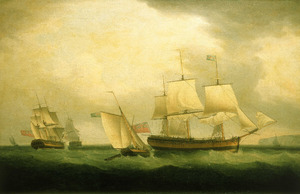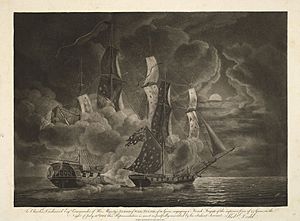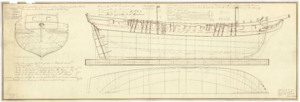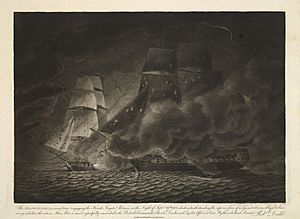HMS Sylph (1795) facts for kids

HMS Sylph (R) and the cutter Mary Ann, 1795
|
|
Quick facts for kids History |
|
|---|---|
| Name | HMS Sylph |
| Namesake | Sylph |
| Ordered | 13 July 1795 |
| Cost | £5,322 |
| Laid down | July 1795 |
| Launched | 3 September 1795 |
| Completed | 23 September 1795 |
| Commissioned | August 1795 |
| Fate | Broken up, April 1811 |
| General characteristics | |
| Class and type | Albatross-class brig-sloop |
| Tons burthen | 36952⁄94 (bm) |
| Length |
|
| Beam | 30 ft 8 in (9.3 m) |
| Depth of hold | 12 ft 9 in (3.9 m) |
| Propulsion | Sails |
| Complement | 121 |
| Armament | Gundeck: 16 × 32-pounder carronades + 2 x 6-pounder bow chasers |
HMS Sylph was a fast, 16-gun warship used by the Royal Navy in the late 1700s. She was a type of ship called a brig-sloop. Designed by William Rule, she was built and launched in 1795. Her name, Sylph, comes from a mythical air spirit.
Sylph was very active during the French Revolutionary Wars. She took part in battles and captured enemy ships. Most of her time was spent patrolling the North Sea, the English Channel, and the coast of Spain. Sylph served until 1805. She was then taken apart in 1811.
Contents
Building a Warship
Sylph was built as a 16-gun brig-sloop. She was part of the Albatross-class of ships. These ships were designed by William Rule. The Royal Navy approved her design in April 1795.
Three ships in her class, including Sylph, were built from fir wood. This was probably because other materials were hard to find during the war. These ships were needed to protect convoys of merchant ships. Sylph was originally planned to have 6-pound long guns. However, the Navy decided to give her heavier 32-pound carronades instead.
Sylph was ordered in July 1795. She was launched on September 3, 1795. The ship was then prepared for sea between September 10 and 23 at Deptford Dockyard. Even though she was designed for 32-pound carronades, these guns were often too heavy. Many ships in her class ended up using smaller 24-pound carronades.
Adventures at Sea
1796: Early Missions
Sylph began her service in August 1795. Her first commander was John Chambers White. She joined the North Sea Fleet. In May 1796, Sylph was sent with other British ships. Their mission was to stop a small Dutch fleet.
On May 12, they found the Dutch ships near the Texel. The Dutch tried to escape. Sylph and another ship, Pegasus, chased the Dutch brigs. After a short battle, Sylph captured the Dutch brig Mercury. Mercury had even thrown fourteen of her sixteen guns overboard to try and get away!
Later that year, Sylph joined a squadron blocking French ports. In August, they were off the Gironde River. They found and chased a French frigate called Andromaque. Sylph helped cut off the French ship. Andromaque was forced ashore and later burned by Sylph's boats. In September, Sylph also captured a French privateer (a privately owned warship) named Le Phoenix.
1797: Battles and Captures
In July 1797, Sylph helped destroy the French frigate La Calliope. This happened off the coast of Brittany. Sylph was with other British ships when they found a French convoy. The convoy was protected by Calliope and two smaller ships.
The smaller French ships escaped. But Calliope ran herself ashore to avoid being captured. Sylph moved in close and fired at Calliope. This made sure the French couldn't save anything from their ship. Calliope broke apart the next day. Sylph had six crew members wounded in this action. The British also captured several French transport ships.
Less than a month later, in August, Sylph attacked another enemy convoy. She was with three other British ships. They found the convoy off the coast of Vendée. The French ships were protected by a fort. Commander White bravely sailed Sylph in to attack. Sylph opened fire from about a mile away. She received fire from the fort and enemy ships. The attack was successful. One French gun-brig was destroyed. Sylph had three crew members killed.
1798: Tracking the Enemy
In February 1798, Sylph helped capture a French privateer. She also captured a French merchant ship in April. In September, a large French force left Brest. They were heading to Ireland to help an invasion.
Sylph was part of a small British squadron that spotted them. Sylph and another ship, Ethalion, followed the French. They kept track of the enemy's path. Sylph was then sent to warn the British commander in Ireland. This warning was very important. It allowed the Royal Navy to gather its forces. This led to the Battle of Tory Island in October. In this battle, the British captured several French ships.
1799: More Encounters
In May 1799, Sylph captured a Spanish packet boat. This happened off Corunna. In July, she took part in an attack on Spanish ships. These ships were in a fortified port called Île-d'Aix. Sylph was part of a British force trying to bombard the Spanish ships.
However, the Spanish had strong forts and floating batteries. Sylph reported that the Spanish guns had a longer range. Spanish gunboats advanced and fired. The British ships had to pull back. Neither side was badly damaged.
In August, Commander Charles Dashwood took command of Sylph. In November, he captured a French lugger (a small sailing vessel). In December, Sylph was caught in a bad storm. Another British ship, Ethalion, was wrecked. Sylph's boats helped rescue 150 survivors. She then brought them safely to Plymouth.
1800–1801: Fierce Fights

Sylph continued to patrol off Spain and in the Channel. In 1801, she had two tough fights with French ships near Santander. These battles might have been against a 44-gun French frigate called L'Artemise.
On July 31, Sylph was chasing a schooner. The large French frigate arrived to protect it. Sylph had to fight the much bigger enemy. The battle lasted over an hour. One man was killed and nine were wounded on Sylph. She had to withdraw to make repairs. The next day, the French frigate seemed damaged. But Sylph was too slow to catch her. Sylph was taking on water and needed major repairs in Plymouth.
After repairs, Sylph returned to her station. On September 28, she found another French frigate. It was similar to her earlier opponent. The two ships fought at very close range for over two hours. The French frigate eventually broke off the fight. Sylph had heavy damage to her rigging. But she had very few casualties, with only one man injured. Commander Dashwood was promoted for his bravery in these two battles.
Later Service and Fate
By November 1801, Sylph was under a new commander, William Goate. She continued her blockade duties in the Channel and North Sea. Sylph was taken out of service for a short time during a peace period. But she was brought back into service in February 1803.
In December 1804, Sylph and two other ships were caught in a severe gale. They had to cut down their masts to avoid being destroyed. This happened off Guernsey. Sylph was repaired and stayed in service until the end of 1805.
Sylph was finally laid up (put into storage) at Portsmouth in November 1805. She was then broken up (taken apart) there in April 1811.



